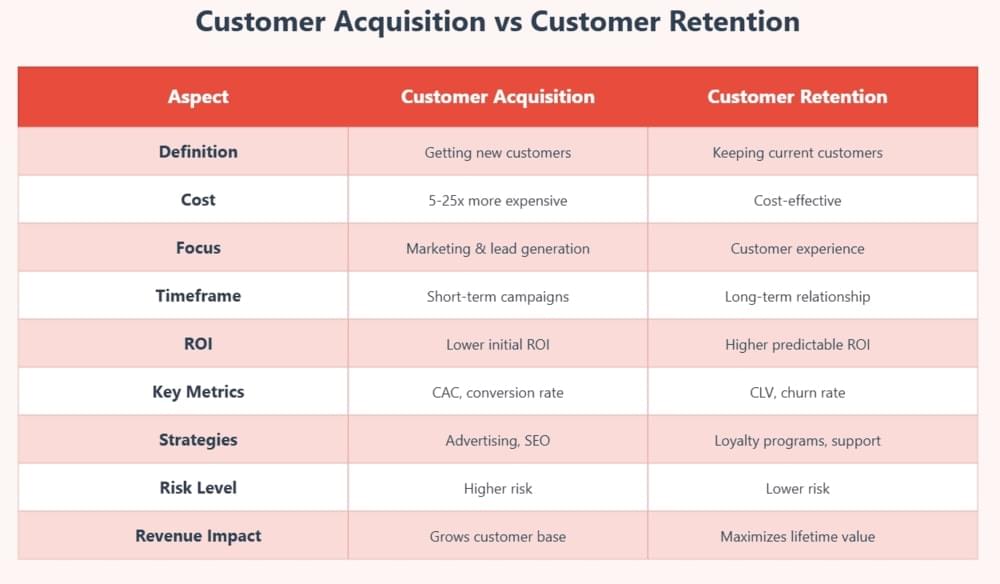
Customer Retention vs Customer Acquisition: Top Differences

Customer retention vs customer acquisition is a common situation many businesses face in varying stages. The crux of this debate is about whether a brand should focus on attracting new customers or keeping the old ones happy and satisfied.
However, it is important to note that between acquisition vs retention, you don’t necessarily have to pick only one option.
In this comprehensive article, we’ll break down everything you need to know about customer acquisition and customer retention to help you understand the key differences and implement the right strategy.
What is Customer Acquisition?
Customer acquisition is the process of attracting new customers to your business. It includes every marketing effort and strategy to turn strangers into paying customers.
A general customer acquisition process involves reaching out to cold prospects, guiding them through the sales funnel, and convincing them that you are offering the best solution to ensure successful conversion.
The primary goal of customer acquisition strategies is to expand your customer reach and get new customers.
What is Customer Retention?
Customer retention is the process of keeping your existing customers satisfied, so they continue to be your paying customers. It involves a wide range of customer engagement strategies to build strong relationships and maximize the customer lifetime value.
The primary goal of customer retention strategies is to reduce churn and increase customer lifetime value.
Core Differences Between Customer Acquisition vs Customer Retention

Let’s discuss the differences between customer acquisition vs retention marketing to better understand how they impact a business:
1. Cost
The most important difference between customer acquisition and customer retention is cost. Acquiring a new customer can cost 5 to 7 times more than retention. Some studies suggest this number to be up to 25 times more expensive.
Such a massive difference is due to the fact that customer acquisition starts from zero. You have to build brand awareness and establish trust with the prospect. Hence, it involves higher ad costs and spending more sales resources to close the deals.
On the other hand, customer retention is possible on existing trust. Your customer already knows about your product’s working, so retention strategies, such as loyalty programs, are easier and cheaper to execute than acquisition strategies.
2. Conversion
Customer retention is a winner when compared to customer acquisition in terms of conversion rate. The probability of successful conversion of a new prospect is anywhere between 5% to 20%. On the other hand, this probability increases to 60% to 70% for existing customers.
This difference is due to the trust gap. New customers are not sure whether you will be able to deliver on your promises, while the existing customers are likely to have seen your product and service firsthand. In SaaS businesses, this difference is huge as it can help them in upselling, cross-selling, and more renewals.
3. Revenue Impact
Statistics show that even a 5% increase in customer retention rate can boost profits by 25% to 95%. In other words, even a modest improvement in keeping the current customers can almost double your profitability.
On the other hand, customer acquisition is essential for growth, but has a lower initial return-on-investment. new customers start with discounted or trial offers, so it can take a significant amount of time before the acquisition turns profitable.
4. Marketing Approach
The marketing approaches of acquisition vs retention are quite different.
Acquisition marketing is persuasive and interruptive. It means brands have to push their message to an audience who is not necessarily aware of it. That’s why customer acquisition strategies involve creating awareness and building trust from scratch.
On the flip side, retention marketing is relationship-driven. It involves engaging the customers and keeping them satisfied with your products and services. That’s why customer retention strategies involve delivering ongoing value and personalized experiences.
5. Metrics
The following table lists the key metrics you have to track and analyze in customer acquisition vs retention:
| Focus Area | Key Metrics |
|---|---|
| Customer Acquisition | - Customer Acquisition Cost (CAC) - Cost per Lead (CPL) - Conversion Rate - Marketing Qualified Leads (MQLs) - Sales Qualified Leads (SQLs) - Time to Conversion - Channel Performance (ROI by source) |
| Customer Retention | - Churn Rate - Customer Lifetime Value (CLV) - Net Revenue Retention (NRR) - Customer Health Score - Repeat Purchase Rate - Net Promoter Score (NPS) - Customer Satisfaction (CSAT) |
Also read: Customer Retention Analytics 101: A Complete Guide
6. Time
Customer acquisition typically yields quicker and more visible results. For example, when you launch a seasonal marketing campaign, you’ll be able to see its impact within weeks. Retention, however, is a long game that provides benefits over a long period of time. A customer retained today can generate massive returns over the years.
Understanding the above differences between customer retention vs acquisition is the key to having a comprehensive strategy that caters to new customers as well as existing ones.
Similarities Between Customer Retention and Acquisition
Despite some significant differences, there are some surprising similarities between customer acquisition and retention:
- Whether you are bringing in new customers or engaging the existing ones, both strategies drive revenue growth.
- Thorough customer understanding is necessary for both types of strategies.
- Your brand promise is likely to attract new customers, while living up to your promises can retain them. So, consistent branding is vital.
- Customer acquisition and customer retention cannot succeed without strategic planning. So, you must establish clear goals and KPIs for strategic resource allocation.
Overall, businesses that treat both customer retention and acquisition as interconnected parts of a comprehensive strategy are likely to succeed in the long run.
When to Focus on Customer Acquisition?
Customer acquisition is essential for the following scenarios:
1. New Business
When you have just started your business and have literally no customers to retain, you have to focus on branding and acquiring new customers. Your focus needs to be on validating the product-market fit in this stage and crafting a marketing campaign that resonates with your target audience.
But, even at this stage, you should try to retain your early customers and turn them into brand advocates.
2. Entering New Markets
If you are expanding your business into a new category or region, you need to focus on acquiring customers who might not be familiar with your brand at all. It is also possible that you want to shift from being a small business to an enterprise, so you’ll essentially be starting over in terms of brand awareness and credibility.
3. Rapid Growth
A business can experience rapid growth if the market conditions are favorable. For instance, you might secure large funding. In such a situation, it is vital to increase your budget towards customer acquisition strategies.
4. Achieve Revenue Goals
Even the most mature companies often struggle to achieve their revenue goals. Moreover, churn rate can increase unpredictably due to a variety of reasons. In such a situation, acquisition becomes important to hit your targets.
5. Businesses with Infrequent Purchases
There are lots of businesses that have a low-frequency purchasing model. For example, a software company offering lifetime subscriptions or even a company selling cars. Customer retention looks significantly different in these business models, and acquisition remains the most important factor for growth.
When to Focus on Customer Retention?
Many businesses, especially SaaS companies, find real success in long-term customer retention. Here are the key situations when you must focus on customer retention strategies:
1. Successful Product-Market Fit
Once you have validated that customers want the products or services you are offering, you should focus on delivering the value continuously and keep the customers engaged. Retention, followed by scaling, can bring sustainability to your revenue growth.
2. Rising Customer Acquisition Costs
If your customer acquisition cost is increasing, you should divert your focus towards improving retention to extend customer lifetime value and bring a balance to your business. You can also use tools like Churnfree to reduce churn via proactive intervention.
3. Established Businesses
If you have built a substantial customer base, you need to make sure you are able to retain the customers as well. The ROI of retention strategies is far superior to customer acquisition.
4. Limited Marketing Budget
If you have a limited marketing budget or if your company is going through a difficult phase, then you’ll find customer retention to be critical for survival. Keeping the current revenue can help you keep your business afloat because it is easier than finding new revenue sources.
5. Customer Feedback
If you are experiencing a high churn rate or seeing consistent patterns in cancellation reasons, it is a clear indication that your retention efforts need quick attention. This is why it is important to collect customer feedback during the cancellation process to make sure you have complete insights about customer experience and make necessary changes.
The Acquisition-Retention Flywheel

The truth is that pitting customer retention and customer acquisition against each other is not a smart thing. The most successful businesses are the ones that know the importance of both of these strategies, and they create a flywheel effect to get the maximum benefits.
Here’s how the flywheel works:
1. Acquisition brings new customers to your business, leading to more reach and revenue.
2. Retention keeps those customers happy, leading to higher profitability.
3. Retained customers advocate for your products or services that bring down the acquisition cost and improve conversion.
4. Lower acquisition costs increase the lifetime value, resulting in higher margins.
5. More data from more customers means you can implement personalized customer marketing and engagement strategies.
Conclusion
The bottom line is that you don’t need to choose between customer acquisition vs customer retention. Instead, you should aim to balance both approaches for optimum and sustainable growth.
Remember, customer acquisition strategies fuel growth, while retention strategies drive long-term profitability. Together, they create the much-needed momentum to make a business successful.
Customer retention software like Churnfree can help you execute effective customer retention strategies to deliver personalized experiences and minimize cancellations. So, try out the tool today for free and get closer to your goal of establishing a successful business.


